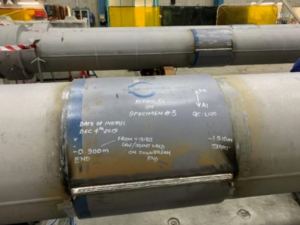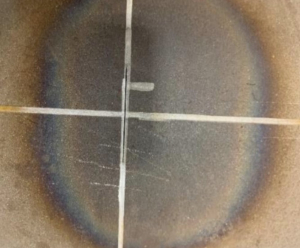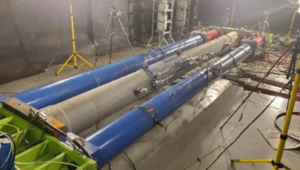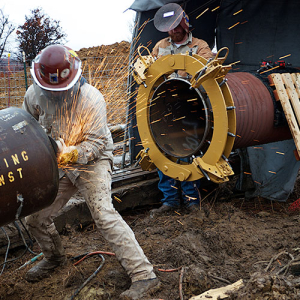Industry tests show promise for non-welded repair of oil and gas pipeline circumferential cracks.
A recent joint industry project led by C-FER Technologies has shown promising results for using Petrosleeve, a non-intrusive repair method, to arrest circumferential crack growth in pipelines.
The multi-phase JIP is testing a range of non-welded repair technologies to determine if they are a safe and cost-effective alternative to repair circumferential cracks compared with traditional methods.
At the 2025 Pipeline Pigging and Integrity Management (PPIM) Conference, PeroSleeve’s Bob Smyth reported on Petrosleeve’s results within the JIP, producing a paper titled Interim Results from the JIP Evaluation of Repair Technologies for Circumferential Cracks on Pipelines of the Steel Compression Reinforcement Sleeve; Repair F (PetroSleeve). This article is a summary of his presentation.
Why research for circumferential crack non-welding repair matters
Traditional repair methods for circumferential cracks typically involve removing the damaged section of pipe or installing a welded Type B sleeve. But both come with tradeoffs. Cutting out pipe can be expensive and disrupt operations, while in-service welding adds complexity and additional risks.
Non-welding solutions offer a fast installation option with less equipment required than metal sleeves, plus the flexibility to repair pipe with non-uniform geometries or where in-service welding may not be feasible.
To explore non-intrusive options, the JIP brought together stakeholders to test six non-intrusive repair technologies. One of them — referred to as “Repair F” in the study — was Petrosleeve.
What is Petrosleeve?
Petrosleeve offers a simple, non-intrusive alternative to traditional forms of circumferential crack repair.
It’s a two-part steel sleeve that clamps around the pipe and is joined by external sidebars – with no welding to the host pipe required. During installation, the pipeline is slightly pressurised, putting the pipe into compression and the sleeve into tension. This creates a tight mechanical bond that helps prevent crack propagation.
Before installation, key parameters like wall thickness, internal pressure, flow rate, and pipe temperature are used with proprietary software to tailor the installation of the repair for each site.
How the circumferential crack non-welding repair methods were tested
C-FER’s JIP evaluated six non-intrusive repair options through a rigorous four-phase program, involving performance tests under pressurised conditions on X52-grade pipe.
The non-intrusive methods tested included wet lay-up, composite fabric, preformed composite coil, steel sleeve, or bolt-on repair sleeve/collar.
Repair F (Petrosleeve) demonstrated robust structural performance across all phases.
Phase 1: structural strength
The repair systems were installed on three sections of 24-inch X52 pipe pressurised to 785 psi (5,400 kPa) to mimic real pipeline conditions.
Each system was subjected to various non-destructive tensile testing situations to compare axial stiffness. This included pressure cycling before being pressurised to 1,170 psi (8,060 kPa) with axial tension applied until a section of the control pipe reached plastic collapse.
Following Phase 1, only three repair methods were selected to participate in further testing. Repair F was deemed acceptable for further testing.

Petrosleeve installed on the pipe specimens used during Phase 1 of the JIP.
Phase 2: installation pressure effects
Phase 2 explored how internal pressure during installation affects repair performance via tests on seven 12-inch vessels pressurised at 30 per cent, 50 per cent and 70 per cent of specified minimum yield strength (SMYS). The vessels were put under tension, and at 72 per cent SMYS, put under tension until failure.
Results showed consistent behavior of Repair F across various pressures, maintaining favorable stiffness ratios, load sharing and strain compatibility with the host pipe. Following Phase 2, Repair F was one of two repair methods deemed acceptable for further testing.
Phase 3: real crack testing
This critical phase introduced simulated circumferential cracks — up to 80 per cent through-wall depth — to evaluate how the repair systems performed under extreme conditions. Each repair system completed the destructive tensile test under varying pressures until they failed.

Photo illustrating the 80 per cent simulated crack.
Each vessel was pressurised to 62.5 per cent SMYS to confirm the crack wouldn’t rupture during the installation of each repair method. The systems were then installed at 50 per cent SMYS and exposed to pressure variances. At 72 per cent SMYS (1,482 psi/10,200 kPa), the vessels were put under tension until failure occurred by increasing tension until the host pipe entered the plastic range and the crack opened.

During Phase 3 tensioning.
Repair F effectively contained the defect under normal operational pressures. The pipe only failed when reaching the plastic range under high tension at 560 Kip (560,000 lb-force) — a level of strain unlikely outside of severe events like landslides or earthquakes. This indicated good containment up to extreme loading.
Phase 4: long-term durability (ongoing)
Phase 4 assesses long-term performance under cyclic pressure. In this test, the participating repair systems were installed on three vessels with an 80 per cent simulated circumferential crack before being put under tension and load to simulate field conditions.
The Repair F Petrosleeve specimens tested in this phase completed 1,000 hours without leaking.
What the interim results show
So far, key observations from the study include evidence of compressive pre-stress between Petrosleeve and the pipe, with crack containment maintained until significant yielding occurs in the parent metal.
Petrosleeve’s results in Phase 3 showed that the repair method only failed when the steel was in the plastic range, with the steel at the edge of the sleeve yielding, reducing the circumference of the pipe and breaking the compressive bond between the pipe and sleeve. This exposed the crack to the tensile force, stretched the steel, and the crack opened.
This suggests Repair F could reliably contain circumferential flaws under normal operational stresses, with failure only likely in rare, high-strain events, such as major geohazards like landslides or earthquakes.
A potential reliable alternative to traditional methods for repairing pipeline circumferential cracks
While testing is ongoing, the early results are promising. Repair F (Petrosleeve) has demonstrated credible performance across short-term mechanical and pressure testing. Ongoing long-term testing will further validate its field viability as a non-welded option for circumferential crack repair.
Petrosleeve could offer pipeline operators a non-intrusive, safe, effective repair method for circumferential cracks — without shutting down operations or risking the hazards of hot welding.
The early JIP results indicate that it can contain significant crack defects and maintain integrity until extremely high strain levels are reached — beyond what most operational scenarios would impose.
For more information on Petrosleeve, contact its exclusive agent for Oceania: Tremco Pipeline Equipment a sales@tremcopipelineequipment.com.au


